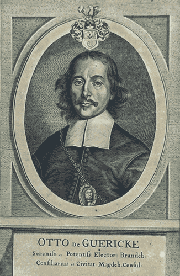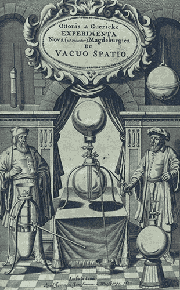|

Otto von Guericke
Otto von Guericke, Experimenta Nova (ut vocantur) Magdeburgica
De Vacuo Spatio, Amsterdam 1672

Otto von Guericke, Experimenta
Nova (ut vocantur) Magdeburgica De Vacuo Spatio, Amsterdam 1672,
frontispiece
|
The descendent of a well-off family
in Magdeburg, he studied Law at the university of Lipsia (1617-1620),
Helmstedt (1620) and Jena (1621-1622), then going to Leida, where
in addition to his legal studies, he went to course of mathematics
and started to deal with engineering problems. After holding various
public posts in his home town, he moved in 1631 to Erfurt, to work
as an engineer for the Swedish government, transferring then to the
service of the Elector of Saxony in 1635. In the years between 1646
and 1676, he held the post of Burgomaster of Magdeburg. Despite the
fact that his time was largely filled by the burdens of public life,
von Guericke continued to interest himself in experimental science,
and was soon aware of the new developments in the debate in physics
related to the innovative cartesian theories, and to the barometric
experiments of Torricelli. To put Descartes' "plenist" thesis, which
denied the existence of the vacuum, to the test, von Guericke thought
up and constructed - alongside many failures - various models of pumps
to produce a vacuum. In the same years, he replicated the barometric
experiments and profoundly studied the problem of air pressure.
It is in this context that, in
1657, Von Guericke performed his most famous experiment. Two bronze
hemispheres, around 50 cm in diameter, and fitting together perfectly,
were put together, and then, with an air-pump, a vacuum was produced
between them. Incredibly, to separate the two parts took the combined
forces of two teams of 8 horses, pulling in opposite directions. The
evocative experiment, first described in Gaspar Schott's Mechanica
hydraulico-pneumatica (1657), and then spectacularly repeated
before the Berlin court in 1663, confirmed the torricellian discoveries
and highlighted the surprising effects of atmospheric pressure.
|

